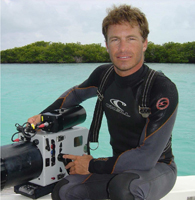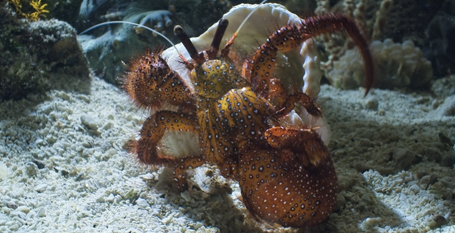
It is 6 am in the morning. David Reichert stands at the stern of a scientific vessel. He must feel like Ahab, quietly anticipating, desperately anticipating for the rare appearance of Moby Dick. The blue whale, an elusive creature made even more elusive by its endangered status, had not turned up as planned. It had simply not turned up where the scientists had predicted the pod’s migratory route – at least, not in the vicinity of the few hundred square miles where the ship was.
The creature was rarely seen up close and never deep underwater – even by the scientists who study it. But it was high on the menu for the marine documentary Jacques Perrin was producing. “It’s endangered! It’s iconic! Only one person captured it on film so far!”, he remembered the excitable Frenchman saying, and so they were prepared to wait for weeks, if necessary, for a whale sighting.
Till then, the team would stay mostly dry on the ship. They might assist the joint scientific mission they had pooled resources and grants with, by loaning their high tech ocean camera systems. The scientific missions Jacques’s crew partnered with around the world were appreciative of what the boost in research capability these gadgets offered. They could swim with the fishes, match them knot for knot, film them in clear, high definition and monitor the camera feeds in real time. And while helping out the scientific missions, they would wait. The record wait was 6 weeks, and this began to feel like a long stakeout.
And then, the sighting. It wasn’t just a solitary blue whale but an entire pod of them, heading for the ship. The mini-helicopter is mobilised as a first response; it will film the whales surface, leaping through the surface of the ocean in graceful synchronity despite their size. David Reichert dons his swimsuit, straps on 20-over pounds of camera gear (which would be weightless underwater) and dives in to get close, real close to get a look at the pod.
The spider crabs of New Caledonia

The depths of the ocean are dark and murky, and full of strong currents that would break the steadycam feature of any commercial camera. When Jacques Perrin wanted to make an underwater documentary, he had thought of all this seemingly insurmountable problems and methodically worked to neutralise them, taking over 3 years in pre-production. A former military engineer who designed the propulsion system for their bathysphere had a hand too in developing the custom-made camera equipment – all five systems of them. He would tinker with the designs like a mad scientist, delivering over six generations of these camera systems.
This would be their ultimate test: a seabed in New Caledonia, 50 feet below the sea. In limited lighting conditions, the mating ritual of a recently discovered new species of spider crab will be filmed. And as always with the shooting of Oceans, this was to be an up close assignment; no long range cameras allowed. Swimming and filming at the same speed with marine life had been previously solved, but it now came to the thorny problem of lighting: these crabs mate only at night.
Their resident mad scientist suggests a solution: a floating platform with lights shining down on the seabed, strong enough to provide lighting for the camera systems, yet mimicking the weak and shifting intensity of a full moon shining through the waters. The idea is debated (Just how strong? How weak? Will the crabs notice and get distracted?) and after some calculations are scrawled out hastily, it is approved.
At some duly appointed time, the spider crabs begin to amass at a spot on the seabed no larger than a living room. The divers too are there nearby, filming the encounter from every possible angle and in high definition. Jacques Perrin views the live feed over a custom-designed system on the vessel. The crabs begin to swarm and squeeze together like in a commuter train at peak hour in Tokyo. Then they start to climb on top of each other, the rhythmic click clack of their claws and pincers providing the soundtrack for their mating. To David Reichert, the aggressive ritual looks almost like a war.
The seals in the Arctic
David Reichert has every reason to be apprehensive about this. Over the past six years, Jacques Perrin and his crew have followed marine creatures great and small over their seasonal migratory routes across the oceans. They have captured an intimate moment of a whale nursing her young, several moments of the fish eat fish world. While there hadn’t been any encounter with man eating sharks, David has his share of bruises from accidental brushes with whales and dolphins.
But this time, it was the Arctic seal. Researchers had told him about the aggressive nature of this species and how they could prove dangerous, funny walks not withstanding. The advice is of little use or comfort: he has to get close to them. This was almost the mantra of the entire production – to get up close to their subjects, to put their audiences on the same page, in the same space as marine life, to see what they see and go through what they experience.
Crouching down, David spies a seal not too far in the distance. The young, non-threatening specimen ambles towards him, making his job all the easier. He readies his camera. Then comes the mother not far behind – a protective hulk, moving with a speed its body design couldn’t have hinted. David’s camera is still rolling. Both seals freeze their tracks at the edge of the ice floe, and the pup takes what must be the first swimming lesson of its life. Mother holds on to the child in its flippers, protective and nurturing, and looks straight into the camera and David.
They would have to include this shot for the final cut of the film, David thinks.
Oceans took 4 years to film. In 75 expeditions across the world’s oceans, Jacques Perrin’s team filmed about 200 species, providing some never-seen-before footage of marine behaviour. There are plans to develop the 500 hours of footage into a 4-part documentary series for the television, as well as plans to convert the film into 3D.












 Printable Version
Printable Version










Reader's Comments
Please log in to use this feature.